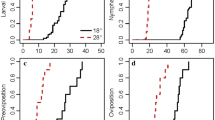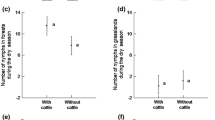Abstract
Four field experiments were conducted with creole cattle in Guadeloupe to study the attractivity for adult ticks of animals previously infested with males of Amblyomma variegatum producing aggregation attachment pheromones (AAPs). In each experiment, two groups of cattle were used; the first group was infested with adult A. variegatum and the second group was kept free of ticks and pheromones by acaricidal treatment and by washing the hair and skin of previously infested sites. Both groups were then exposed to natural infestation by ticks present in the environment or by ticks bred in the laboratory and released on the pasture. The number of additional ticks infesting animals were compared between the treated and control groups. There were no significant differences between both groups in the numbers of new male ticks infesting the animals during the first days following the beginning of the experiment. Thereafter, comparison of the slopes of infestation indicated that infested cattle were no more attractive for male ticks than uninfested hosts. Uninfested cattle were spontaneously and rapidly infested by male ticks. It is concluded that carbon dioxide or another host component was a major attractant for A. variegatum males. Female ticks attached on predilection sites exclusively in the presence of AAP-producing males, i.e. 5–10 days after the attachment of the first males. Based on these results we postulate that slow-release devices impregnated with pheromones have no additional attractive effect on A. variegatum males under Caribbean conditions. However, they may be useful in inducing the attachment of females, but only in the first days preceding the arrival of pioneer AAP-producing males. © Rapid Science Ltd. 1998
Similar content being viewed by others
REFERENCES
Barré, N. 1989. Biologie et écologie de la tique Amblyomma variegatum(Acarina: Ixodina) en Guadeloupe, Antilles Françaises. Thése Doctorat, Paris-Sud, Orsay.
Barré, N. and Garris, G.I. 1990. Biology and ecology of Amblyomma variegatum(Acari: Ixodidae) in the Caribbean: implications for a regional eradication program. J. Agricult. Entomol. 7(1): 1-9.
Barré, N. and Pavis, C. 1992. Essai d'attraction d'Amblyomma variegatum(Acarina: Ixodina) sur des bovins préalablement traités avec des phéromones d'agrégation-fixation et un acaricide pyréthrinoýde. Rev. Elev. Med. Vét. Pays Trop. 45: 33-36.
Barré, N., Garris, G. and Camus, E. 1995. Propagation of the tick Amblyomma variegatumin the Caribbean. Rev. Sci. Tech Off. Int. Epiz. 14: 841-855.
Barré, N., Garris, G.I. and Lorvelec, O. 1997. Field sampling of the tick Amblyomma variegatum(Acari: Ixodidae) on pastures in Guadeloupe; attraction of CO2 and/or tick pheromones and conditions of use. Exp. Appl. Acarol. 21: 95-108.
Diehl, P.A., Guerin, P., Vlimant, M. and Steullet, P. 1991. Biosynthesis, production site, and emission rates of aggregation-attachment pheromone in males of two Amblyommaticks. J. Chem. Ecol. 17: 833-847.
FAO, 1992. Programme for the eradication of Amblyomma variegatumfrom the Caribbean. FAO, Rome.
Hess, E. and de Castro, J.J. 1986. Field tests of the response of female Amblyomma variegatum(Acari: Ixodidae) to the synthetic aggregation-attachment pheromone and its components. Exp. Appl. Acarol. 2: 249-255.
Lusby, W.R., Sonenshine, D.E., Yunker, C.E., Norval, R.A. and Burridge, M.J. 1991. Comparison of known and suspected pheromonal constituents in males of the African ticks, Amblyomma hebraeumKoch and Amblyomma variegatum(Fabricius). Exp. Appl. Acarol. 13: 143-152.
Norval, R.A.I. and Rechav, Y. 1979. An assembly pheromone and its perception in the tick Amblyomma variegatum(Acari: Ixodidae). J. Med. Entomol. 16: 507-511.
Norval, R.A.I., Andrew, H.R. and Yunker, C.E. 1989. Pheromone-mediation of host-selection in bont ticks (Amblyomma hebraeumKoch). Science 243: 364-365.
Norval, R.A.I., Yunker, C.E., Duncan, I.M. and Peter, T. 1991a. Pheromone/acaricide mixtures in the control of the tick Amblyomma hebraeum: effects of acaricides on attraction and attachment. Exp. Appl. Acarol. 11: 233-240.
Norval, R.A.I., Peter, T., Yunker, C.E., Sonenshine, D.E. and Burridge, M.J. 1991b. Responses of the ticks Amblyomma hebraeumand A. variegatumto known or potential components of the aggregation-attachment pheromone. I. Long range attraction. Exp. Appl. Acarol. 13: 11-18.
Norval, R.A.I., Sonenshine, D.E., Allan, S.A. and Burridge, M.J. 1996. Efficacity of pheromone- acaricide-impregnated tail-tag decoys for controlling the bont tick, Amblyomma hebraeum(Acari: Ixodidae), on cattle in Zimbabwe. Exp. Appl. Acarol. 20: 31-46.
Pavis, C. and Barré, N. 1993. Kinetics of male pheromone production by Amblyomma variegatum(Acari: Ixodidae). J. Med. Entomol. 30: 961-965.
Price, T.L., Sonenshine, D.E., Norval, R.A., Yunker, C.E. and Burridge, M.I. 1994. Pheromonal composition of two species of African Amblyommaticks: similarities, differences and possible species specific components. Exp. Appl. Acarol. 18(1): 37-50.
SAS Institute Inc. 1988. SAS/STAT User's Guide, Release 6.03 Edition. SAS Institute Inc., Cary, NC.
Schöni, R., Hess, E., Blum, W. and Ramstein, K. 1984. The aggregation-attachment pheromone of the tropical bont tick, Amblyomma variegatumFabricius (Acari: Ixodidae). Isolation, identification and action of its components. J. Insect Physiol. 30: 613-618.
Sonenshine, D.E., Silverstein, R.M. and Rechav, Y. 1982. Tick pheromone mechanisms. In: Physiology of ticks, F.D. Obenchain and R. Galun (eds), pp. 439-468. Pergamon, Oxford.
Steullet, P. and Guerin, P.M. 1992. Perception of breath components by the tropical bont tick, Amblyomma variegatumFabricius (Ixodidae). I. CO2-excited and CO2-inhibited receptors. J. Comp. Physiol. 170: 665-676.
Uilenberg, G., Barré, N., Camus, E., Burridge, M.J. and Garris, G.I. 1984. Heartwater in the Caribbean. Prev. Vet. Med. 2: 255-267.
Rights and permissions
About this article
Cite this article
Barré, N., Naves, M., Aprelon, R. et al. Attractivity of cattle infested by Amblyomma variegatum (Acari: Ixodidae) for conspecific adult ticks from the field in Guadeloupe. Exp Appl Acarol 22, 297–308 (1998). https://doi.org/10.1023/A:1006078717952
Issue Date:
DOI: https://doi.org/10.1023/A:1006078717952




